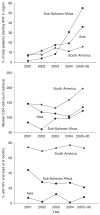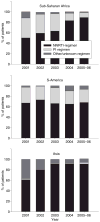Antiretroviral therapy in resource-limited settings 1996 to 2006: patient characteristics, treatment regimens and monitoring in sub-Saharan Africa, Asia and Latin America
- PMID: 18373510
- PMCID: PMC3722496
- DOI: 10.1111/j.1365-3156.2008.02078.x
Antiretroviral therapy in resource-limited settings 1996 to 2006: patient characteristics, treatment regimens and monitoring in sub-Saharan Africa, Asia and Latin America
Abstract
Objectives: To describe temporal trends in baseline clinical characteristics, initial treatment regimens and monitoring of patients starting antiretroviral therapy (ART) in resource-limited settings.
Methods: We analysed data from 17 ART programmes in 12 countries in sub-Saharan Africa, South America and Asia. Patients aged 16 years or older with documented date of start of highly active ART (HAART) were included. Data were analysed by calculating medians, interquartile ranges (IQR) and percentages by regions and time periods. Not all centres provided data for 2006 and 2005 and 2006 were therefore combined.
Results: A total of 36,715 patients who started ART 1996-2006 were included in the analysis. Patient numbers increased substantially in sub-Saharan Africa and Asia, and the number of initial regimens declined, to four and five, respectively, in 2005-2006. In South America 20 regimes were used in 2005-2006. A combination of 3TC/D4T/NVP was used for 56% of African patients and 42% of Asian patients; AZT/3TC/EFV was used in 33% of patients in South America. The median baseline CD4 count increased in recent years, to 122 cells/microl (IQR 53-194) in 2005-2006 in Africa, 134 cells/microl (IQR 72-191) in Asia, and 197 cells/microl (IQR 61-277) in South America, but 77%, 78% and 51%, respectively, started with <200 cells/microl in 2005-2006. In all regions baseline CD4 cell counts were higher in women than men: differences were 22cells/microl in Africa, 65 cells/microl in Asia and 10 cells/microl in South America. In 2005-2006 a viral load at 6 months was available in 21% of patients Africa, 8% of Asian patients and 73% of patients in South America. Corresponding figures for 6-month CD4 cell counts were 74%, 77% and 81%.
Conclusions: The public health approach to providing ART proposed by the World Health Organization has been implemented in sub-Saharan Africa and Asia. Although CD4 cell counts at the start of ART have increased in recent years, most patients continue to start with counts well below the recommended threshold. Particular attention should be paid to more timely initiation of ART in HIV-infected men.
Figures


References
-
- Anastos K, Shi Q, French AL, et al. Total lymphocyte count, hemoglobin, and delayed-type hypersensitivity as predictors of death and AIDS illness in HIV-1-infected women receiving highly active antiretroviral therapy. Journal of 1 Acquired Immune Deficiency Syndrome. 2004;35:383–392. - PubMed
-
- Beck E, Vitoria JM, Mandalia S, et al. National adult antiretroviral therapy guidelines in resource-limited countries: concordance with 2003 WHO guidelines? AIDS. 2006;20:1497–1502. - PubMed
-
- Bekker LG, Myer L, Orrell C, et al. Rapid scale-up of a community-based HIV treatment service: programme performance over 3 consecutive years in Guguletu, South Africa. South African Medicne Journal. 2006;96:315–320. - PubMed
-
- Braitstein P, Brinkhof MWG, Dabis F, et al. Mortality of HIV-1-infected patients in the first year of antiretroviral therapy: comparison between low-income and high-income countries. Lancet. 2006;367:817–824. - PubMed
-
- Braitstein P, Boulle A, Nash D, et al. Gender and the use of potent antiretroviral treatment in resource-constrained settings: Findings from a multi-centre collaboration. Journal of Women’s Health. 2008;17:47–55. - PubMed
Publication types
MeSH terms
Substances
Grants and funding
LinkOut - more resources
Full Text Sources
Medical
Research Materials

